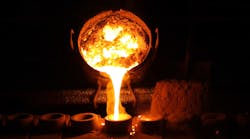This article was updated Jan. 9, 2023. It was originally published April 1, 2016.
RELATED
The difference between wrought and cast iron is straightforward: Cast iron has been melted, poured into a mold and allowed to cool. Wrought iron has been heated and worked with tools. (FYI, the term “wrought” traces its origins to the word “worked.”)
Here are some more distinguishing details of the two common forms of iron.
Cast iron is a generic term for iron alloys containing 2 to 4% carbon, along with smaller amounts of silicon and manganese and impurities such as sulfur and phosphorus. The most common of these alloys is gray iron.
Cast iron is formed by smelting iron ore or melting pig iron (a product of iron ore extraction), then mixing it with scrap metals and other alloys. The molten mixture gets poured into molds to cool and solidify, which it does as a heterogeneous alloy containing several materials in different phases. The specific materials and phases in each cast-iron alloy affect its physical properties.
Cast iron is harder, more brittle, and not as malleable as wrought iron or steel. It can’t be bent, stretched, or hammered into shape. It has little tensile strength, so it fractures before it bends or distorts. On the positive side, it has high compression strength, which made it critical for constructing buildings in the early 20th Century before steel became available.
Compared to steel, cast iron has a lower melting point. It is also more fluid and reacts less with mold materials, making it well-suited for casting. It takes significantly less labor to cast a part rather than forging a wrought-iron version of the part. This made cast iron a prominent material throughout the 18th and 19th Centuries. It has largely been replaced by steel in construction, but is still used in many industrial applications.
Wrought iron consists primarily of iron with 1 to 2% of added slag, which is the byproduct of iron ore smelting, and is a mix of silicon, sulfur, phosphorous, and aluminum oxides. During manufacture, the iron is removed from heat and worked with a hammer while still hot to get it into its final form.
Wrought iron is softer and more ductile than cast iron. It is also highly malleable and can be heated, re-heated and worked into various shapes. In fact, it gets stronger the more it is worked.
Wrought iron has much more tensile strength than cast iron, making it more suitable for horizontal beams in construction. In general, it strongly resists fatigue and deforms without failing unless overloaded well beyond capacity or distorted from exposure to intense heat.
Like cast iron, it was widely used throughout the 19th Century in constructing buildings but was replaced by steel in the 20th Century. Today, wrought iron is used primarily for decorative purposes.
Corrosion affects cast and wrought iron parts if they have bare metal surfaces and are exposed to oxygen in the presence of moisture. Unlike metals such as copper or aluminum that form protective oxidative coatings, iron will rust and flake away entirely given enough time. This makes cast and wrought iron parts and assemblies problematic for outdoor environments with its precipitation and humidity.
To prevent rust, iron products should be coated to prevent exposure of the bare metal. Paint is commonly used to protect bare metal. Powder coatings are another method and well-suited for outdoor furnishings susceptible to wear in high-traffic areas. Powder coatings are durable and won’t fade, chip, or crack over extended periods of time.
Brad Done was vice president of the Reliance Foundry Co. Ltd. in British Columbia, Canada when he wrote this article.


